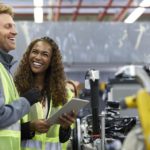 As the world has gained a more realistic understanding of just what automated technologies can and cannot do, the fears about robots taking our jobs have abated somewhat. These fears have perhaps been assuaged by the widespread labor shortages seen around the world.
As the world has gained a more realistic understanding of just what automated technologies can and cannot do, the fears about robots taking our jobs have abated somewhat. These fears have perhaps been assuaged by the widespread labor shortages seen around the world.
A recent paper from Brigham Young University provides another reminder that our jobs are unlikely to be at risk from robots for a bit longer yet. Indeed, the researchers believe we’re often prone to greatly exaggerate the risk of automation taking our jobs.
Limited risk
The study reveals that just 14% of workers say they’ve ever seen a human being replaced by a robot. There is, however, a sense among those for whom automation has befallen them to exaggerate the risk of this happening across the economy by around 300%.
The researchers quizzed around 2,000 workers to understand their perceived risk of automation affecting their work. They began by asking workers what percentage of employees they believed had been automated by robots. This was followed up by questions asking whether they themselves had suffered a similar fate.
While only around 14% of employees had suffered from automation themselves, those people were much more likely to believe others had also been replaced by machines. Indeed, these people thought nearly half of workers had been automated, which compares to a figure of just 29% among the entire sample.
“Overall, our perceptions of robots taking over is greatly exaggerated,” the researchers explain. “Those who hadn’t lost jobs overestimated by about double, and those who had lost jobs overestimated by about three times.”
Wild claims
The researchers believe that this false sense of risk is perhaps driven by the attention-grabbing headlines that have dominated the last few years, with many predicting millions of jobs will be lost to the relentless march of technology.
“We expect novel technologies to be adopted without considering all of the relevant contextual impediments such as cultural, economic, and government arrangements that support the manufacturing, sale, and use of the technology,” the researchers explain. “But just because a technology can be used for something does not mean that it will be implemented.”
The findings chime with previous research showing that far from replacing humans in the workplace, most new technologies are being installed to work alongside employees, with this combination generating more value than either man or machine in isolation.
“An everyday example is an autonomous, self-propelled machine roaming the isles and cleaning floors at your local grocery store,” the researchers continue. “This robot cleans the floors while employees clean under shelves or other difficult-to-reach places.”